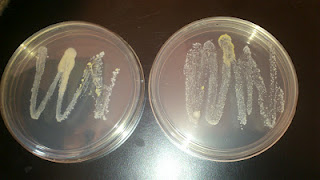INTRODUCTION
A microorganism or microbe is an organism that is unicellular or lives in a colony of cellular organisms. Microorganisms contamination is a situation which occurs when microorganisms end up in a location where they are not supposed to be. It is often used to refer to contamination of food by bacteria which can cause disease, but microorganisms contamination can also occur in other settings. This situation is not desirable, because it can pose a health threat and cause other problems. As microorganisms, particularly bacteria, are found practically everywhere, this means in most cases the reduction of harmful microorganisms to acceptable levels. However, in some cases it is required that an object or substance be completely sterile, i.e. devoid of all living entities and viruses.
Although a number of microorganisms are present in air, it doesn't have an indigenous flora. Air is not a natural environment for microorganisms as it doesn't contain enough moisture and nutrients to support their growth and reproduction.
In food preparation microorganisms are reduced by preservation methods (such as the addition of vinegar), clean utensils used in preparation, short storage periods or by cool temperatures. If complete sterility is needed, the two most common methods are irradiation and the use of an autoclave, which resembles a pressure cooker. There are no conditions where all microorganisms would grow, and therefore often several different methods are needed.
OBJECTIVE
To determine the microorganisms in the air and from healthy human
RESULT
.JPG) |
| NORMAL BREATHING |
.JPG) |
| VIOLENT COUGHING |
 |
| AIR |
 |
| HAND |
 |
| EAR |
DISCUSSION
Air currents may bring the microorganisms from plant or animal surfaces into air. These organisms may be either commensals or plant or animal pathogens. However, the transmission of animal diseases is not usually important in outside air.
The main source of airborne microorganisms is human beings. Their surface flora may be shed at times and may be disseminated into the air. Similarly, the commensal as well as pathogenic flora of the upper respiratory tract and the mouth are constantly discharged into the air by activities like coughing, sneezing, talking and laughing. The microorganisms are discharged out in three different forms which are grouped on the basis of their relative size and moisture content. They are droplets, droplet nuclei and infectious dust.
Everyone knows that flu viruses and cold germs can congregate on hands. Also found on the hands are the bacteria that cause gastrointestinal problems. One of the most common types of bacteria known to man is staph. Because in recent years staph is becoming increasingly resistant to antibiotics which can prove deadly, washing your hands is more than good hygiene, it can save your life.
The respiratory system is open to airborne microbes and to outside pollution.It is not surprising that respiratory diseases occur, in spite of the body's defenses. Some respiratory disorders are relatively mild and, unfortunately, very familiar. We all experience the excess mucus, coughing, and sneezing ofthe common cold from time to time. The common cold is an example of rhinitis, an inflammation of the epithelium lining the nose and nasal cavity. Viruses, bacteria, and allergens are among the causes of rhinitis. Other respiratory disorders include laryngitis, pneumonia, bronchitis, chronic obstructive pulmonary disease, and lung cancer.
The cough reflex is a vital part of the body's defence mechanisms. Normally, the lungs and the lower respiratory passages are sterile. If dust or dirt get into the lungs, they could become a breeding ground for bacteria and cause pneumonia or infection in the breathing tubes. When a person coughs, there is a short intake of breath and the larynx (the voice box) closes momentarily. The resulting blast of air comes out at high speed, scrubbing and clearing the airway of dust, dirt or excessive secretions.
CONCLUSION
Bacteria are everywhere and can spread from surface to surface, person to person, food to food, and person to food. Harmful bacteria can be controlled by practicing the 4 Cs of food safety. To prevent the spread of harmful bacteria, proper cleaning of both hands and surfaces is especially important. The good thing is that not all bacteria are harmful; most bacteria are beneficial to us.
When designing experiments, you should always use safe techniques when working with bacteria. Also, it's important to have a control plate. In this experiment, you also learned that different strains of bacteria can be identified through colony morphology.
No comments:
Post a Comment